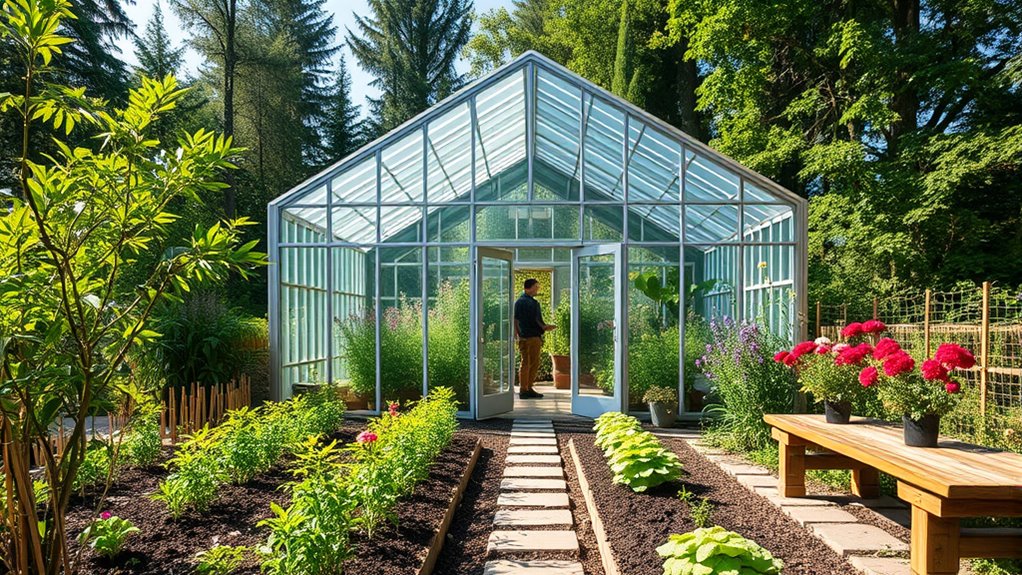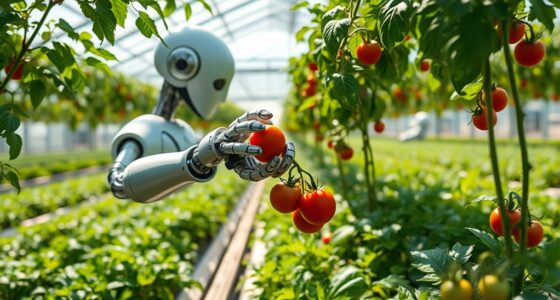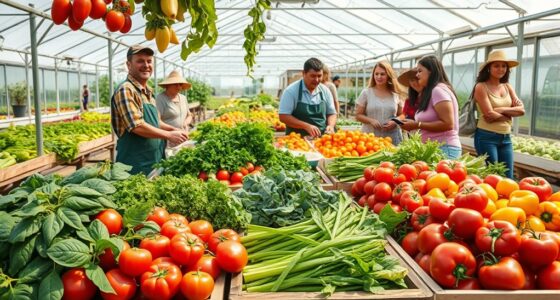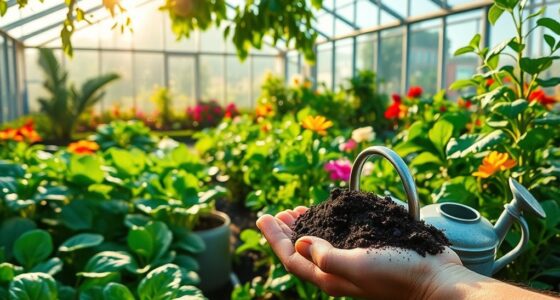When building your greenhouse, opt for eco-friendly materials like reclaimed wood, bamboo, or hempcrete. These choices not only have lower carbon footprints but also enhance durability. For glazing, consider recycled polycarbonate or low-emissivity glass to improve energy efficiency. Integrating renewable energy solutions like solar panels and maintaining sustainable practices, such as drip irrigation, keep your greenhouse thriving. There’s more to discover about the advantages of these materials and practices that can make your greenhouse even more sustainable.
Key Takeaways
- Opt for sustainable materials like reclaimed wood and bamboo, which have lower carbon footprints and enhance durability.
- Incorporate eco-friendly glazing options such as low-emissivity glass or recycled polycarbonate panels to improve energy efficiency.
- Utilize natural insulation materials like hempcrete and fiber composites for excellent thermal performance in greenhouses.
- Implement renewable energy solutions, like solar panels and biomass systems, to power greenhouse operations sustainably.
- Adopt sustainable maintenance practices, such as drip irrigation and composting, to enhance resource efficiency and reduce environmental impact.
Understanding Sustainable Building Materials
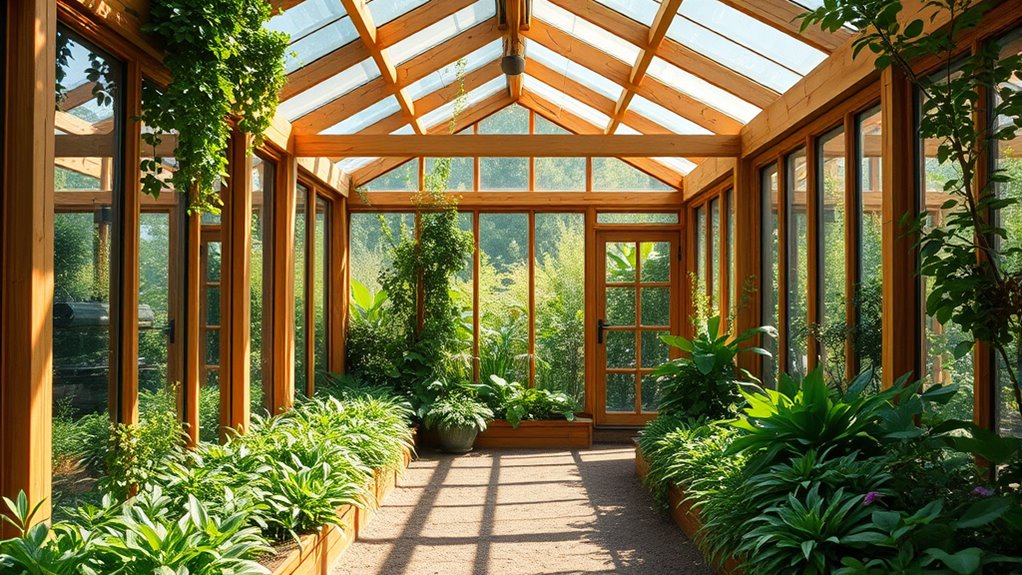
When you consider building sustainably, understanding sustainable building materials is essential. These materials have a minimal environmental impact throughout their lifecycle, helping to reduce waste and conserve natural resources. Enhancing life at home for the elderly can also be achieved through thoughtful use of these materials, ensuring comfort and safety in their living spaces.
By choosing options like bamboo, cork, and hempcrete, you can create structures that not only look great but also support healthier living environments. Sustainable materials are vital in reducing carbon emissions and promoting environmentally responsible construction practices. For instance, bamboo’s fast growth makes it a strong contender for framing, while cork provides excellent insulation without harming trees. Additionally, recycled steel is a sustainable material that can be endlessly recycled, contributing to resource conservation. Using backyard greenhouses as a means to grow your own food can further enhance your commitment to sustainability and reduce your carbon footprint. Moreover, incorporating solar energy solutions into your building design can significantly lower energy costs and decrease reliance on non-renewable resources.
Exploring Eco-Friendly Glazing Options
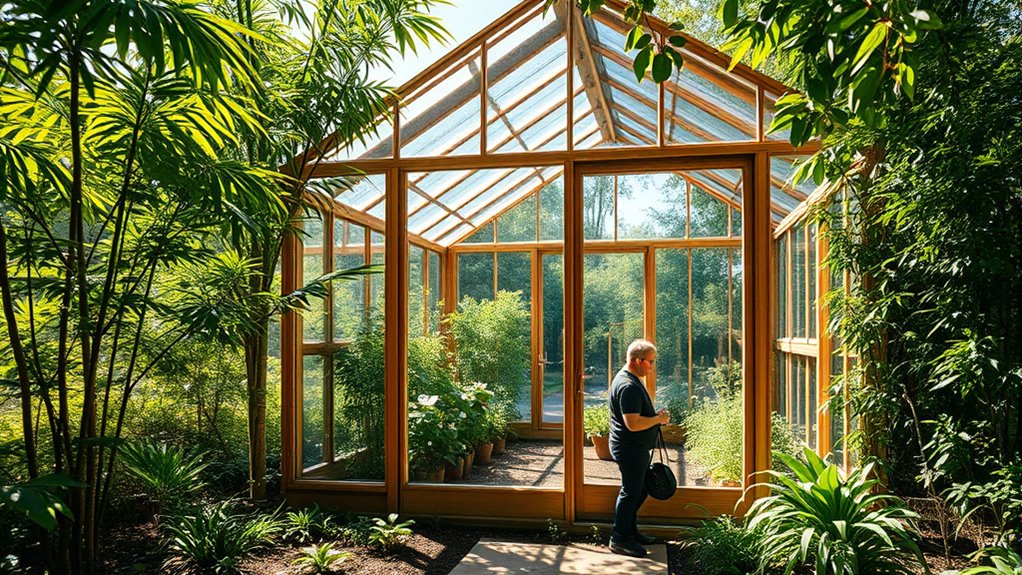
Choosing sustainable building materials lays the groundwork for eco-friendly structures, but the right glazing options are equally important in creating an efficient greenhouse.
You’ll find several eco-friendly glazing choices that not only enhance light transmission but also support sustainability. Recycled polycarbonate panels offer durability and good light diffusion, while tempered glass remains a classic, fully recyclable option. Additionally, selecting materials with high thermal insulation properties can significantly improve energy efficiency in your greenhouse. Adding chia seeds to your diet can also enhance overall health, similar to how choosing the right materials boosts your greenhouse’s performance. It’s vital to consider advance directives when planning for the future, ensuring that all decisions regarding your greenhouse align with your long-term sustainability goals.
Biodegradable plastic panels present a budget-friendly choice for temporary setups, breaking down naturally. For added thermal insulation, consider fiberglass panels, which combine recycled materials. Energy-efficient glass is a crucial aspect to consider, as low-emissivity varieties boost your greenhouse’s performance.
By selecting the right glazing, you protect your plants and contribute to a greener environment, making your greenhouse both functional and eco-conscious.
Enhancing Energy Efficiency and Insulation
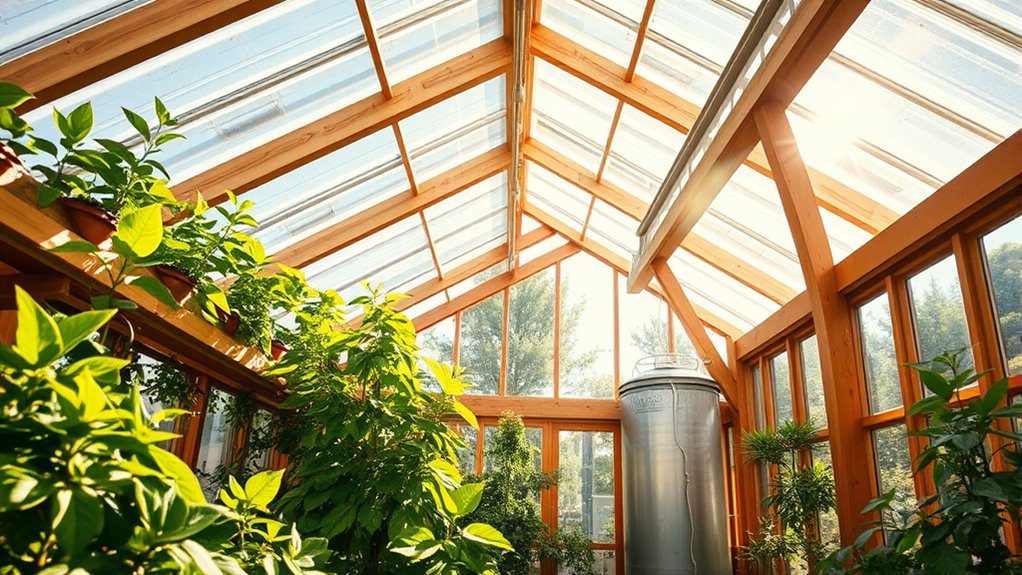
To enhance energy efficiency and insulation in your greenhouse, consider integrating sustainable materials and innovative design features.
Use reclaimed wood or bamboo frameworks for their durability and low carbon footprint. For insulation, hempcrete and natural fiber composites provide excellent thermal performance with minimal environmental impact. Implementing passive solar design techniques can further optimize energy use by harnessing natural sunlight, while also reducing the pollutants linked to wood-burning that can negatively impact air quality. Utilizing efficient wood stoves can also provide a sustainable heating option for your greenhouse without compromising indoor air quality. An understanding of mental wellbeing can also promote a positive mindset as you engage with your greenhouse project.
Incorporate thermal mass materials like stone or water barrels to regulate temperature throughout the day. Position your greenhouse strategically to maximize sunlight, reducing heating needs.
Apply passive solar design techniques and guarantee tight construction to minimize heat loss. Additionally, invest in thermal energy curtains and efficient ventilation systems to maintain ideal conditions while conserving energy.
With these strategies, you’ll create a greenhouse that’s both eco-friendly and energy-efficient.
Integrating Renewable Energy Solutions
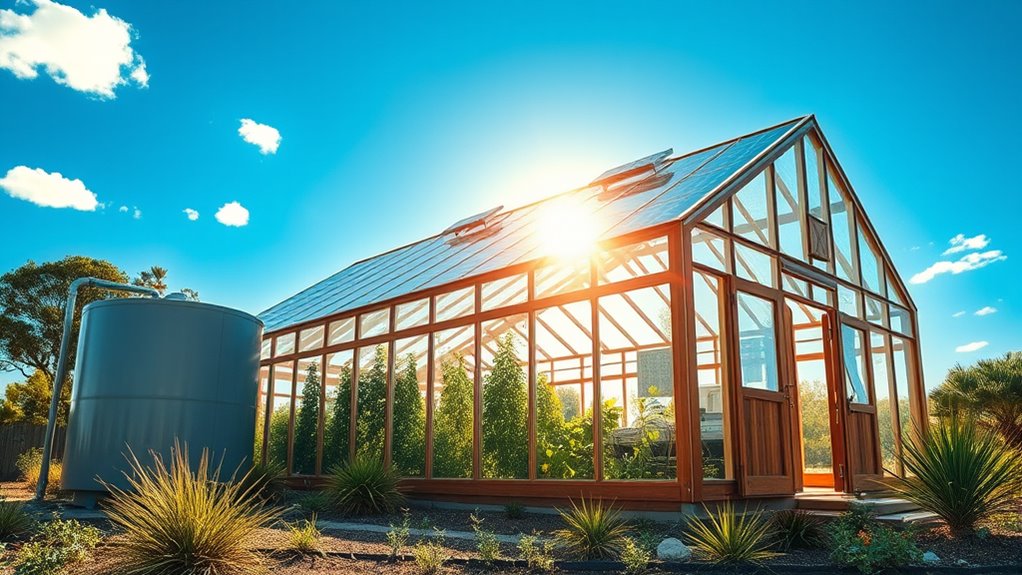
Integrating renewable energy solutions in your greenhouse not only boosts sustainability but also cuts operating costs.
By installing solar panels on the roof, you can harness sunlight for electricity, while wind turbines can generate energy in breezy areas. In fact, average turbine efficiencies can significantly enhance your energy output. The use of renewable energy technologies is becoming increasingly essential for modern greenhouse operations. Additionally, incorporating solar charge controllers can optimize energy harvest from solar panels, improving overall efficiency.
Consider biomass systems, which convert organic waste into reliable heating and electricity sources. Transitioning to renewable energy sources is crucial for energy efficiency in greenhouse operations.
Solar thermal systems efficiently heat your greenhouse, and bio-digesters can provide hydrogen for fuel cells.
Designing for energy integration, like using passive solar design or energy curtains, maximizes natural resources.
Upgrading to LED lighting and heat pumps enhances efficiency.
With government incentives available, you’ll find that embracing renewable energy not only helps the environment but also supports your bottom line.
Implementing Sustainable Practices for Maintenance
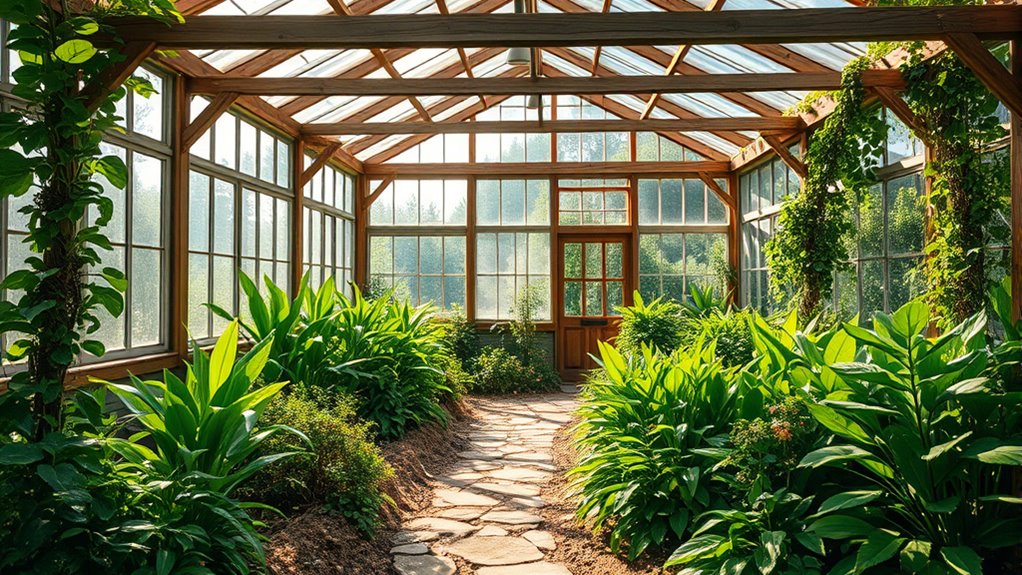
While maintaining your greenhouse, adopting sustainable practices is essential for promoting a healthy environment and optimizing productivity. Regular cleaning and sanitation help prevent disease transmission, while proper pruning and waste management reduce pest spread. Always inspect new plants before introducing them to ascertain you’re not bringing unwanted pests or diseases into your space.
Maintain your irrigation system to avoid water waste, and regularly check your heating and cooling systems for efficiency. Using modern heat pumps can enhance energy efficiency and reduce your greenhouse’s carbon footprint. Heat pumps can achieve efficiencies of 300-600%, making them a highly effective solution for sustainable heating. Additionally, proper sizing during installation is crucial for maximizing performance and efficiency. Use drip irrigation and consider rainwater harvesting to conserve water. Furthermore, repurpose old materials and compost plant waste to minimize landfill contributions. By implementing these sustainable practices, you’ll enhance resource efficiency and create a thriving greenhouse ecosystem. Moreover, focusing on energy efficiency not only reduces operational costs but also contributes to a lower overall carbon footprint for your greenhouse.
Evaluating Cost-Effective and Long-Term Benefits
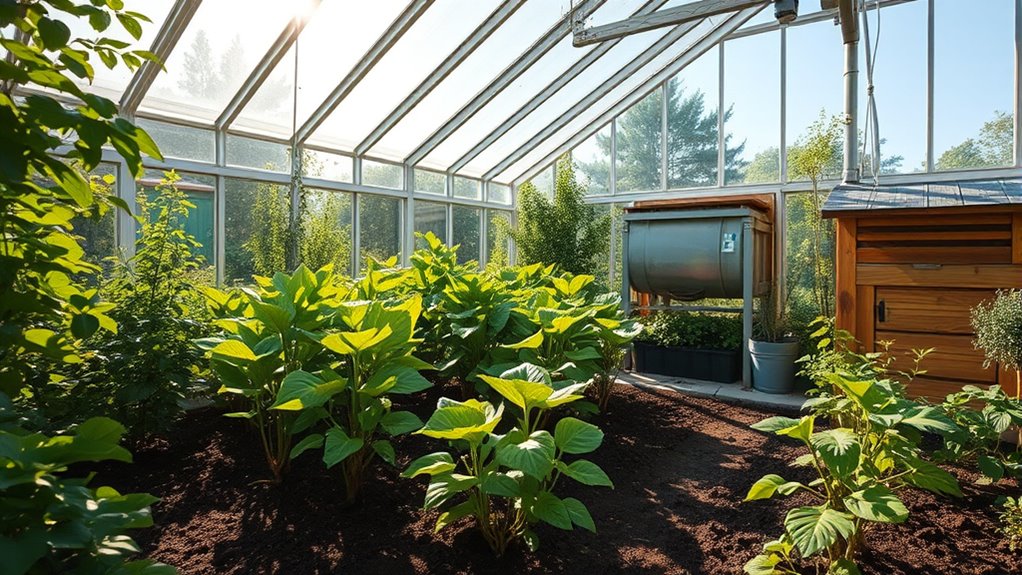
When choosing materials for your greenhouse, it’s crucial to balance cost-effectiveness with long-term benefits. Consider options like recycled plastic panels and polycarbonate panels; they provide excellent insulation and durability, reducing energy costs over time. Portable AC Units can enhance your greenhouse environment by maintaining optimal temperature during hot weather, contributing to better plant growth. Additionally, utilizing self-watering planters can help ensure that your plants receive consistent moisture, further promoting their health. Bamboo frameworks and recycled steel are sustainable choices that strengthen your structure while minimizing environmental impact. Additionally, the use of AI technologies in material selection can help identify the most suitable options based on performance and sustainability metrics. Engineered lumber offers the strength of solid wood but at a lower cost, making it budget-friendly. Local climate significantly influences material choice for durability and insulation, ensuring that your greenhouse is well-suited to its environment. Though initial costs might be higher for durable materials like polycarbonate, they often lead to lower maintenance expenses. By investing in eco-friendly materials, you enhance indoor air quality and create a healthier environment, ensuring your greenhouse thrives for years to come. Make informed decisions today for lasting benefits tomorrow.
The Role of Reclaimed Wood in Greenhouses

Reclaimed wood plays an essential role in greenhouse construction, offering both sustainability and aesthetic appeal. By repurposing materials that might otherwise end up in landfills, you reduce waste and lower your carbon footprint. This choice supports sustainable forestry practices and helps conserve forests, which benefits biodiversity. The unique textures and colors of reclaimed wood not only provide a rustic charm but also add character to your greenhouse. You can use it for various components, enhancing durability due to its dense nature. Plus, sourcing locally supports your community’s economy. Additionally, using reclaimed wood supports sustainability by reducing the demand for new lumber and the associated environmental impacts. Incorporating natural materials like reclaimed wood can create a warm and inviting atmosphere in your greenhouse. With proper treatment and maintenance, reclaimed wood can guarantee long-term structural integrity, making it an eco-friendly and visually appealing option for your greenhouse. Moreover, choosing reclaimed wood often aligns with sustainable building practices, promoting an eco-conscious approach to construction.
The Advantages of Bamboo as a Building Material
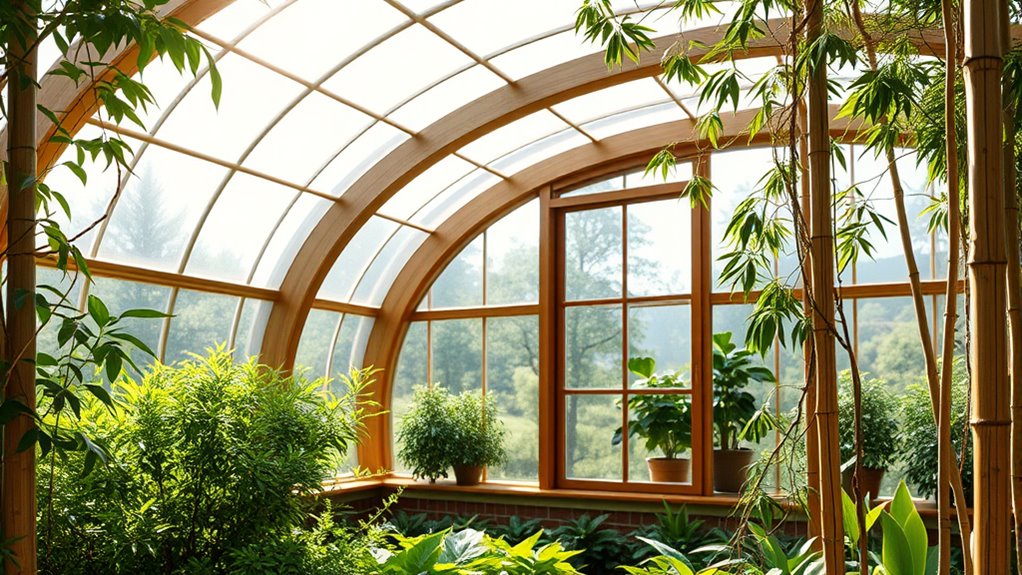
Bamboo stands out as an exceptional building material due to its rapid renewability and impressive structural properties. It matures in just three to five years, making it a highly sustainable option. With a lower carbon footprint than steel, bamboo actively contributes to reducing greenhouse gas emissions. Its tensile strength rivals that of steel, while its flexibility allows it to endure seismic activity and strong winds. Bamboo’s natural resistance to water damage minimizes maintenance needs, and its affordability makes it accessible for various builders and homeowners. Additionally, bamboo’s aesthetic appeal and versatility enhance both traditional and modern architectural styles, offering you creative design possibilities for your greenhouse. Furthermore, bamboo is a rapidly renewable resource that can help mitigate the impact of deforestation and promote sustainable construction practices. Using bamboo supports eco-friendly practices while ensuring durability and cost savings.
Innovations in Recycled Materials for Greenhouse Construction
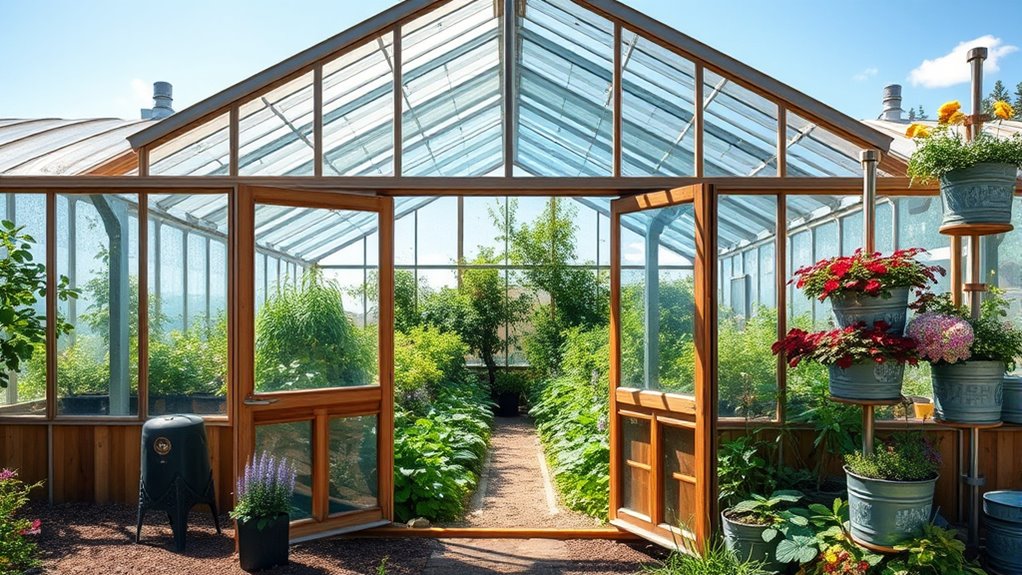
As the demand for sustainable building practices grows, innovations in recycled materials for greenhouse construction offer exciting solutions that benefit both the environment and your gardening endeavors.
You can use reclaimed wood from old barns or warehouses, giving materials a second life while reducing new lumber demand. Recycled plastic panels provide durability and excellent insulation, while glass alternatives made from recycled sources enhance energy efficiency. Incorporation of tool storage into the greenhouse design can also maximize functionality and ensure that your gardening tools are conveniently accessible.
Consider using recycled steel for a sturdy framework, and repurpose old windows or doors for unique character. Sourcing materials from building sites and community networks can lead to hidden gems.
Frequently Asked Questions
How Do I Choose the Right Materials for My Greenhouse Location?
To choose the right materials for your greenhouse location, start by evaluating your local climate.
Consider weather resistance and insulation needs based on temperature extremes. Look for materials that provide UV protection in sunny areas and guarantee adequate ventilation for air circulation.
Additionally, think about the sustainability of materials and how they’ll perform over time.
What Are the Most Durable Eco-Friendly Materials Available?
Did you know that using recycled materials can reduce construction waste by up to 90%?
When it comes to durable eco-friendly materials, consider options like reclaimed wood, recycled steel, and bamboo frameworks. These materials not only offer strength and longevity but also make a positive environmental impact.
Don’t overlook recycled polycarbonate panels and tempered glass, which provide excellent insulation while being eco-conscious choices.
You’ll create a sustainable structure that lasts!
Can I Mix Different Materials for My Greenhouse Construction?
Absolutely, you can mix different materials for your greenhouse construction!
Combining materials can enhance strength, insulation, and aesthetics. For example, you might use a metal frame for durability while opting for polycarbonate panels for lightweight insulation.
Just verify that the materials work well together and suit your climate. Mixing materials can also help you optimize costs and sustainability, allowing you to create a unique structure that meets your specific needs.
How Does Climate Affect the Choice of Greenhouse Materials?
Climate greatly impacts your choice of greenhouse materials.
You’ll need to take into account temperature fluctuations, humidity levels, and UV exposure, which can affect durability. For instance, materials must withstand wind and snow loads in your region.
If you live in a humid area, corrosion-resistant options are essential.
Ultimately, selecting materials tailored to your local climate guarantees your greenhouse remains functional and sustainable over time, maximizing both performance and longevity.
What Are the Best Practices for Sourcing Sustainable Materials Locally?
Sourcing sustainable materials locally is like planting seeds in your own backyard; it nurtures growth and strengthens your community.
Start by researching local suppliers who prioritize eco-friendly practices. Evaluate materials for durability and minimal environmental impact. Look for green certifications to guarantee quality.
Implement closed-loop recycling systems to reuse resources efficiently. By choosing local, you’ll reduce transportation emissions, support the economy, and promote environmental preservation, creating a more sustainable future for everyone.
Conclusion
In choosing eco-friendly materials for your greenhouse, you’re not just building a structure; you’re crafting a legacy for future generations. Like a steadfast oak tree, your choices can stand the test of time, nurturing both plants and the planet. By embracing sustainable options, you’re not only enhancing energy efficiency but also sowing the seeds of environmental stewardship. Let your greenhouse be a beacon of hope, where nature thrives and innovation flourishes, reminding us that every small choice can lead to monumental change.
